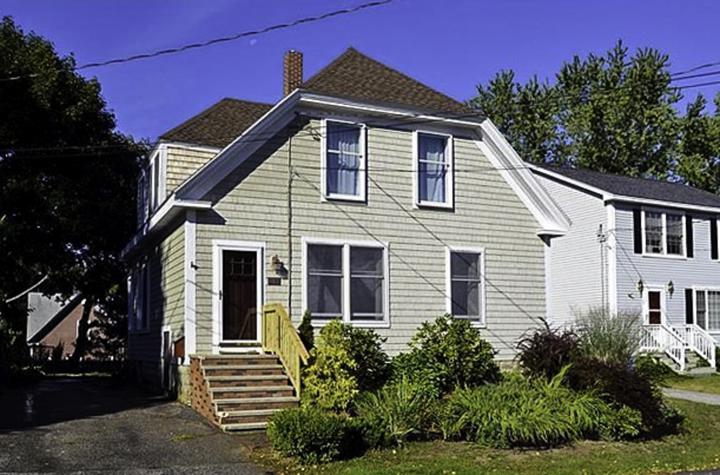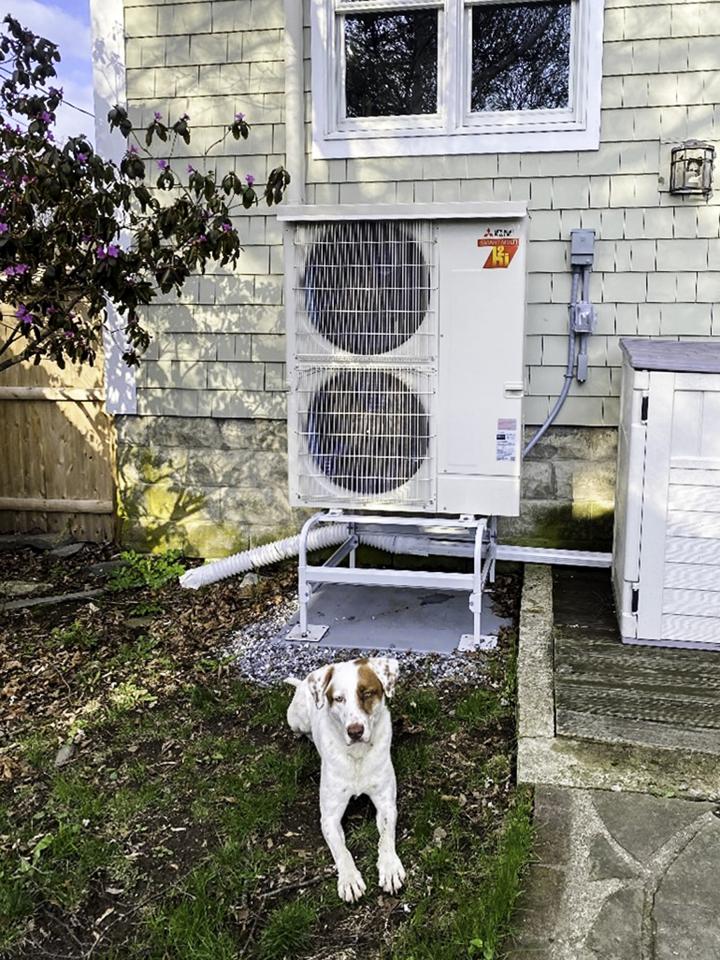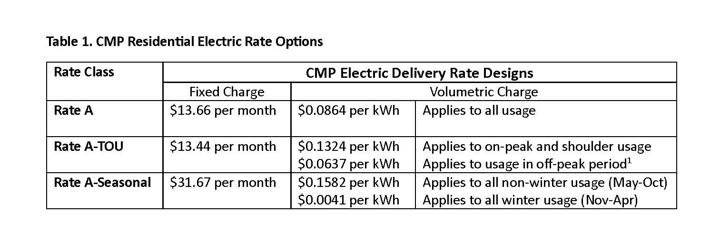
By Eben Perkins, Vice President, Consulting
My wife and I live in South Portland, Maine in a single-family home that was built in 1920. We moved into the house in 2016, shown below, and have been slowly working our way through a project list that has taken us on an interesting adventure from the basement up to the attic. We’ve gotten a first-hand lesson about how to deal with mold and bats upstairs, and how to jerry-rig the wooden fence in the backyard to not fall over from the wind. YouTube videos have been our savior.
As we’ve been making these improvements throughout the house, we’ve been electrifying our appliances, heating system, and vehicles. In 2019, we bought an electric vehicle and upgraded our ancient electric panel to be able to install a Level II charger in the driveway. Last year, we decided it was time to deal with the house being a sub-zero tundra during the winter. Being stuck at home for most of winter 2020/2021 due to the pandemic made us appreciate how little insulation the house has. The insulation in the walls consisted of torn up newspapers from a bygone era. Combined with the fact that our gas boiler is nearing the end of life, the house had a forced hot air system installed nearly 15 years ago, it was time to throw off the blankets and make the house a bit warmer.

After looking at our heating options, we landed on installing an air-source heat pump system and properly insulating the basement and attic. The ASHP is a 4-ton Mitsubishi system that feeds four indoor units: two wall-mounted units on the first floor of the house and two floor-mounted units on the second floor of the house. We kept the old gas boiler for backup heat (more to come on that point) and are continuing to use the existing gas-fired domestic water heater. Thanks to the great teams at Evergreen Home Performance and Royal River Heat Pumps, we wrapped up the installation work last October just as the leaves were starting to fall.
Coming out of our first winter with the heat pumps, the system worked great. The most noticeable change was the lack of noise from the forced hot air system not running. The near silence of the heat pump was a huge improvement over the noise from the gas boiler and forced hot air, which sounded like a plane taking off in our living room every time the boiler kicked on. While we would opt for the forced hot air takeoff over the din of a steam radiator in the middle of the night, it is fun to learn that heat pumps provide an alternative with little to no noise.
As we were considering installing heat pumps, we were concerned about how the system would run on cold days and nights. For 99% of this winter, we had no issues with this. The Mitsubishi model that we chose continues to run in temperatures as low as -20 degrees. Excluding the extreme cold we experienced during the first weekend of February, when temperatures dropped below -20 degrees, the heat pumps ran without a hitch and kept the house very comfortable. The insulation added to the basement and attic made a noticeable difference and contribution, along with window inserts for the front and side of the house. We strongly recommend that anyone considering heat pumps reaches out to an advisor (like Evergreen here in Southern Maine) to get an energy efficiency audit and to see how insulation in their home can be maximized.

During that first weekend in February, the heat pump system shut off due to the extreme cold. When the heat pump was installed, we dialed back our thermostat setting for the gas boiler to 60 degrees. Once the house cooled to this point, the gas boiler started up and ran for the rest of the cold spell without any issues. While we got a newfound appreciation for the sound of forced hot air, it made us seriously think about what we would do moving forward when the boiler fails and needs to be replaced. Resistance baseboard heating is a low-cost option to provide backup to a heat pump during extreme cold. However, without having a backup generator at the house, baseboard heating and forced hot air systems wouldn’t provide redundancy for heating in the event of a winter grid outage.
As heat pump installations throughout Maine and New England continue to increase in the coming years, it will be interesting to see how the gas distribution utilities respond in future rate cases and regulatory proceedings. Reviewing the gas bills for our house over the past six months, I expect that our annual gas usage will fall by more than 85% compared to prior years. While we still use some gas for domestic hot water, the volume is small, and we will likely replace the gas-fired water heat with an electric solution once its reaches end of life. While our gas usage has fallen off a cliff, we continue to rely on the gas system as a critical backup for heating in extreme cold. The pipes in our home likely would have frozen during the first weekend in February without the gas boiler being available for backup heat.
As natural gas utilities lose throughput due to residential and commercial heat pump conversions, unit costs must increase for the utilities to meet the revenue requirements of their systems, which in the near term have fixed costs to maintain. This dynamic leads to higher gas delivery rates, which in turn incentivizes more end users to convert to heat pumps powered by electricity. This risk of a downward spiral for gas distribution utilities is becoming a focus of public utility commissions in U.S. states with deep decarbonization goals, including Massachusetts, California, and New York, that are seeking significant reductions in natural gas use in the coming decades.[1] During CES’ upcoming annual seminar in June titled “Bridging the Future: Managing the Energy Commodity Transition,” we plan to discuss this issue in more depth.
Another key takeaway from our first winter with heat pumps is that electric utilities’ rate designs can make a significant difference in the cost of running a heat pump and incentivizing gas, propane, or oil customers to convert to heat pumps. When we first moved into the house, we used approximately 5,000 kilowatt-hours (“kWh”) per year. After purchasing an electric vehicle (EV,) our annual electric usage doubled to around 10,000 kWh per year based on roughly 15,000 miles of driving per year. The heat pump system has added another 5,000 kWh of electric usage during the heating season, bringing our expected annual usage to a total of 15,000 kWh per year. This usage may increase further depending on how often we run the heat pump for cooling this summer, though both my wife and I were raised to be frugal, guilt-ridden Yankees, we will likely limit air conditioning to the hottest days of the year.
During the 2021 legislative session, the Maine State Legislature enacted several laws that required the Maine Public Utilities Commission (the “Commission”) to examine whether electric utilities’ rate designs support and promote state policies related to the state’s decarbonization efforts. In July 2021, the Commission issued a Notice of Inquiry under Docket Number 2021-00198 seeking responses to certain questions raised in the legislation as well as other rate design matters. Comments from various parties, including Competitive Energy Services (CES), discussed principles of rate design and how rates should be designed to promote the use of distributed generation, load reduction, and the reduction of greenhouse gases. In October 2021, the Commission issued a Notice of Investigation initiating Docket Number 2021-00325 to consider electric utility rate design issues as required, in part, by the recently enacted legislation and to support related state policies regarding climate change and beneficial electrification. The investigation considered rates for energy storage technologies, EVs, and heat pumps. The Notice of Investigation required that to the extent not already filed, Maine’s electric utilities (including both investor-owned and consumer-owned utilities) submit proposals for rates for energy storage-related end uses, residential EV charging, and heat pumps, including for space and water heating end uses.
CES was an active participant in these rate design proceedings, and we proposed a number of changes to Versant Power’s and Central Maine Power Company’s transmission and distribution rate structures that we believe would make substantial improvements in how Maine’s electric utilities send residential and commercial customers accurate price signals on the actual cost of using the power grid at different times of the year and the day. By sending proper price signals, CMP and Versant can incentivize additional heat pump adoption that will benefit all customers through rising electric sales and delivery revenues that can be utilized to lower electric delivery rates.
One of the notable outcomes of Docket 2021-00325 was CMP creating a new residential rate class, Rate A-Seasonal. This rate class is a pilot rate limited to 5,000 participants that have heat pumps installed at home. As shown in Table 1, under Rate A-Seasonal CMP applies a significantly lower electric delivery rate (which includes transmission and distribution components) during the heating season from November to April compared to the months of May to October. This seasonal pricing differentiation is economically justified because CMP sizes its transmission and distribution system capacity based on peak grid demands in the summer months, when the grid’s carrying capacity is much lower than the winter during hot, humid conditions. By increasing delivery rates during the non-winter months and reducing delivery rates during the winter months when heat pumps run in heating mode, CMP sends participating customers an effective message that in the near term using the grid during the heating season incurs minimal incremental service costs for ratepayers. This in turn supports heat pump adoption by lowering heat pumps’ operating costs.

Table 2 shows our expected annual costs under CMP’s three residential tariffs. Before we installed our air source heat-pumps the basic Rate A tariff provided the lowest cost. After adding an electric car there is very little difference between the three tariff options – assuming equal charging throughout the year. By installing heat pumps and participating in Rate A-Seasonal, we expect to reduce our annual electric delivery costs by $325 per year relative to the other residential tariff options, or roughly 20% of our total annual delivery charges assessed by CMP. This figure excludes our electricity supply costs, which CMP bills but are charged by the default electricity supplier, not CMP. Our experience suggests that the Commission should expand Rate A-Seasonal to more CMP customers, and ideally implement this type of seasonal rate differentiation for all customers and grid uses.

[1] In Massachusetts, this proceeding is being managed by the Massachusetts Department of Public Utilities under Docket Number 20-80. In California, this proceeding is being managed by the California Public Service Commission under Rulemaking 20-07-007. In New York, this proceeding is being managed by the New York Public Service Commission under Case 20-G-0131.
[2] CMP’s off-peak period includes the hours between 8 P.M. and 7 A.M. on weekdays and all hours on holidays and weekends. Reviewing our house’s hourly electric data without the EV charging load, our base electric demand from appliances and the heat pump system breaks down to roughly 50% of kWh used during off-peak hours and 50% of kWh used during on-peak and shoulder hours.
Photo by Danil Silantev
